Brian Samoriski, PhD, Bristol Instruments Inc.
Many laser applications, including high-resolution spectroscopy, optical remote sensing, cooling/trapping, and optical fiber communications, are highly dependent on a laser's spectral performance. Therefore, it is important to characterize laser parameters such as absolute wavelength, wavelength stability, linewidth, and longitudinal mode structure. There are a variety of instruments that can provide this information, but most systems do not provide a complete picture. Wavelength meters measure absolute wavelength very accurately, but provide little or no spectral information. To determine a laser's spectrum (power vs wavelength), a spectrum analyzer is necessary. These systems have high resolution, but their wavelength measurement accuracy is limited. The 721 series laser spectrum analyzer from Bristol Instruments, however, is a unique instrument that provides the most complete spectral characterization available.
Wavelength Meters
Wavelength meters use optical interferometry to measure a laser's absolute wavelength very accurately. Measurements are made in real-time resulting in the ability to automatically report and control laser wavelength. Two types of interferometers are used. These are the Michelson interferometer and the 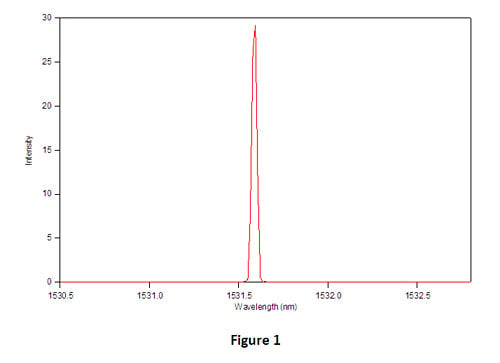 Fizeau etalon.
Fizeau etalon.
Figure 1: The Michelson interferometer with FFT analysis is very flexible with the types of lasers that can be analyzed, especially with regard to the laser's wavelength. Since the Michelson interferometer uses a single element photodetector, a variety of such photodetectors are readily available for operation from the ultraviolet into the mid-infrared.
Michelson Interferometer
The scanning-mirror Michelson interferometer generates information from the interference of two beams that originate from the same source. The optical input is split between a fixed path and a path that is smoothly changing in length. Both beams are reflected and recombined to produce an interference pattern that is a consequence of the changing phase relationship between the beams. This temporal interference pattern is analyzed by counting the number of interference fringes generated during the scan of the mirror. This results in the ability to measure absolute laser wavelength to an accuracy as high as ± 0.0001 nm. No other spectral information is provided, however. 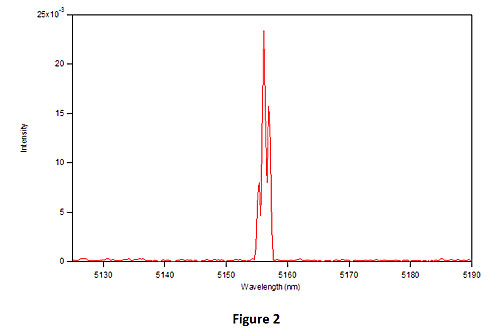
Figure 2 shows the spectrum of a quantum cascade laser (QCL) that operates at about 5.1 m. The 721 series laser spectrum analyzer is the only system available to characterize the spectrum of lasers that operate beyond about 2.5 m. Another advantage of this technique is that there is not a limited measurement window. A broad optical signal, such as a typical DWDM fiber communications signal, can be measured by the 721 series laser spectrum analyzer.
Fizeau Etalon
This type of wavelength meter uses fixed-spaced Fizeau etalons to generate a spatial interference pattern. Data is collected by imaging the interference patterns onto a photodetector array. The spacing between the interference fringes is measured and then used to calculate absolute laser wavelength. In general, the Fizeau etalon-based wavelength meter is used to provide 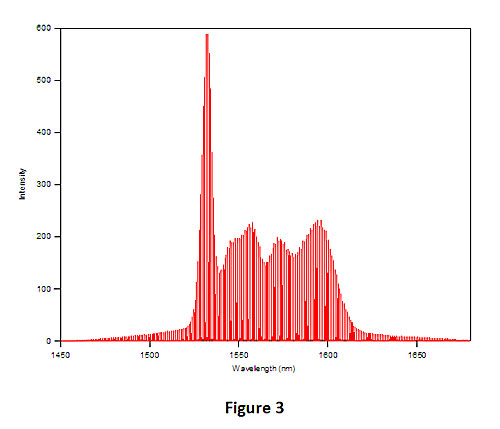 wavelength information only. In some instances, however, the spectral
wavelength information only. In some instances, however, the spectral
Figure 3 shows a "simulated" DWDM signal that is generated by sending a broad ASE source through a Fabry-Perot etalon with a free spectral range of 100 GHz. The entire spectrum of the etalon transmission is shown, giving the spectral profile of the ASE source over the wavelength range of about 1450 to 1650 nm.
Spectrum Analzyers
A spectrum analyzer is used to determine a laser's spectrum, which is a measure of laser power vs wavelength. Two techniques are commonly used in commercially available systems. These are the Fabry-Perot interferometer and the diffraction grating.
Fabry-Perot Interferometer
This is a simple device that relies on the interference of multiple beams. It consists of two partially transmitting mirrors precisely aligned to form a reflective cavity. Incident light enters the Fabry-Perot interferometer and undergoes multiple reflections between the mirrors so that the light interferes 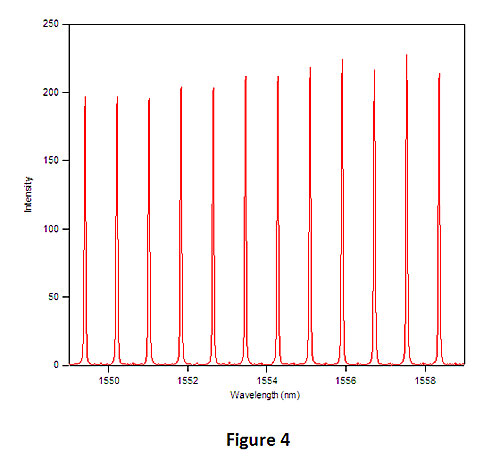 with itself many times. This results in an interference pattern that is
with itself many times. This results in an interference pattern that is
Figure 4 shows a magnified portion of this spectrum. The "simulated" optical channels (individual peaks) are shown with a frequency separation of 100 GHz. In addition to laser sources, the Michelson interferometer-based spectrum analyzer technique employed by the 721 system can measure a variety of other optical signals.
characteristic of the laser's power vs wavelength spectrum. The primary advantage of this type of laser spectrum analyzer is its spectral resolution which can be better than 10 MHz, or 0.00003 nm at 1000 nm. Therefore, it is ideal for measuring laser linewidth, longitudinal mode structure, and wavelength stability. However, the Fabry-Perot interferometer only provides relative information so it will not measure absolute laser wavelength.
Optical Spectrum Analyzer (OSA)
Instruments identified as optical spectrum analyzers, or OSAs, typically employ diffraction grating technology. The diffraction grating is a dispersive element that splits the incident light into several beams travelling in different directions. The number and direction of these beams depend on the wavelength of the incident light. The diffracted beams are imaged onto a photodetector array for analysis. The primary advantage of such a spectrum analyzer is its ability to make precise measurements on the power axis of the spectrum. An OSA is, in effect, a wavelength-selective optical power meter. That is, it can measure the absolute power of the spectral components very accurately. It also has excellent sensitivity and a low noise floor resulting in the ability to measure low power optical signals. However, the OSA's ability to measure absolute wavelength is limited to an accuracy of about ± 0.01 nm, and a typical spectral resolution is only about 0.07 nm.
721 Series Laser Spectrum Analyzer
For scientists and engineers who need the most complete spectral characterization of their laser, the 721 series laser spectrum analyzer is basically a wavelength meter and spectrum analyzer in one instrument. The 721 system measures absolute wavelength to an accuracy as high as +/- 0.0001 nm and determines the laser's power vs wavelength spectrum to a resolution as high as 4 GHz, or 0.01 nm at 1000 nm.

Figure 5 shows the measured spectrum from a fiber Bragg grating (FBG) when it is at two different temperatures. The red spectrum is generated when the FBG is at 25°C, and the blue spectrum is the result when the FBG is at 63°C. This data demonstrates the effectiveness of this instrument as an interrogator for FBG temperature and/or pressure sensors, especially with long-term wavelength measurement accuracy.
The 721 system is similar to a Michelson interferometer-based wavelength meter. However, instead of simply counting interference fringes to calculate wavelength, it uses a fast Fourier transform (FFT) to analyze the interference pattern. That is, the Michelson interferometer generates a temporal interference signal with a waveform that is representative of all the frequency (wavelength) components of the laser under test. By doing an FFT, a conventional optical frequency (wavelength) spectrum can be derived resulting in the desired spectral information.
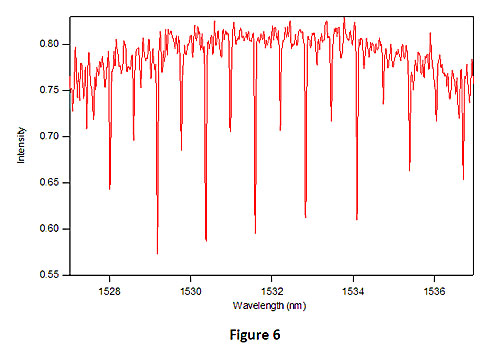
Figure 6 shows the spectrum of a broad ASE source that is transmitted through an acetylene gas absorption cell. In this case, the 721 series laser spectrum analyzer is used in a way similar to a typical FTIR spectrometer.
An example of this technique is given in Figure 1, which shows the spectrum, generated by a 721A Laser Spectrum Analyzer, of a DFB laser locked to the absorption of acetylene at 1531.587836 nm (Gilbert, S.L. and Swann, W.C. Acetylene 12C2H2 Absorption Reference for 1510 to 1540 nm Wavelength Calibration — SRM 2517a. National Institute of Standards and Technology Special Publication 260-133: 2000). In its wavelength meter mode, the 721A system measured the laser's absolute wavelength as 1531.5879 nm. The difference from the NIST accepted value is 0.1 pm, which is well within the instrument's uncertainty of ± 0.3 pm. The 721A system's spectrum analyzer mode provides the power vs wavelength spectrum showing a single peak with a linewidth (FWHM) of 4 GHz, the spectral resolution of the instrument.
There are several types of instruments available to measure the different spectral properties of a laser. Some measure absolute wavelength very accurately, and others perform better at measuring the laser's power vs wavelength spectrum. For the most complete laser spectral characterization, however, instruments that employ the Michelson interferometer with FFT analysis technique, such as the 721 series laser spectrum analyzer from Bristol Instruments, may be the best choice. These systems combine high-accuracy wavelength measurement and high-resolution spectral analysis, and offer the versatility required for a variety of applications.